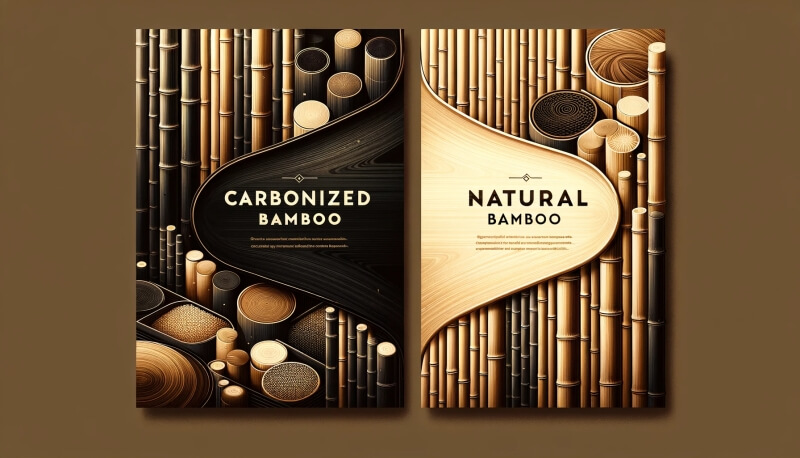Key Takeaways
| Aspect | Carbonized Bamboo | Natural Bamboo |
|---|---|---|
| Appearance | Dark, rich, wooden color | Light, airy, straw-like color |
| Water Resistance | Less resistant to moisture | More resistant to moisture |
| Durability | Less durable | More durable |
| Maintenance | Requires more maintenance | Requires less maintenance |
| Cost | Generally more expensive | Generally less expensive |
| Best Use | Living rooms, dining rooms | Kitchens, bathrooms, living rooms |
| Lifespan | 20-25 years (with maintenance) | 20-25 years |
Bamboo, a rapidly renewable resource, has become a popular material in various products, from flooring to furniture. In this exploration, we delve into the differences between carbonized and natural bamboo, focusing on their characteristics, uses, and suitability for different environments. Understanding these differences is crucial, especially for those considering bamboo-based products like mahjong mats and bamboo flooring.
What is Carbonized Bamboo?
Carbonized bamboo is known for its dark, rich color, resembling hardwood flooring. This appearance is achieved through a process called carbonization, where bamboo canes are harvested, stripped, and then boiled to remove sugars and prevent expansion. The bamboo is then smoked, giving it a darker tone but slightly weakening its structure. Its aesthetic appeal makes it a popular choice for main living areas like lounges and dining rooms.
Manufacturing Process
The process begins with harvesting bamboo canes, followed by boiling and carbonization. This involves steaming and smoking the bamboo for an extended period, leading to its darker coloration. The final stage is bonding the strips to form planks. This process not only alters the bamboo's color but also its structural integrity.
Durability and Maintenance
Carbonized bamboo is not as durable as its natural counterpart due to the carbonization process. It's softer and more prone to damage and fading, requiring more maintenance. For detailed information on maintaining carbonized bamboo's durability, see Is Carbonized Bamboo Durable?
Understanding Natural Bamboo
Natural bamboo, in contrast, retains a light, lemony color, as it does not undergo the smoking process. This means it maintains its natural strength and structure, making it more durable and versatile. It's a practical choice for areas like kitchens and bathrooms due to its higher resistance to moisture and heavy use.
Appearance and Use
Natural bamboo flooring showcases the natural golden and blonde hues of bamboo. It's versatile and can be used across various parts of a home, including moisture-prone areas. For those interested in incorporating bamboo into their homes, learn how to make bamboo mahjong mats.
Advantages and Cost
Natural bamboo flooring is more affordable and requires less maintenance compared to carbonized bamboo. It's highly durable and can withstand the weight of heavy furniture, making it suitable for different areas of a home.
Comparing Carbonized and Natural Bamboo
When comparing the two, several factors come into play:
Aesthetic Appeal
- Carbonized Bamboo: Offers a darker, smokier look ideal for living spaces.
- Natural Bamboo: Has a lighter hue, suitable for a range of interior styles.
Durability and Maintenance
- Carbonized Bamboo: Less durable and requires more upkeep.
- Natural Bamboo: More durable and easier to maintain.
Suitability for Different Environments
- Carbonized Bamboo: Ideal for living rooms and dining areas but not recommended for high moisture areas like kitchens or bathrooms.
- Natural Bamboo: Highly versatile, suitable for kitchens, bathrooms, and other areas.
Addressing Common Queries
Is Carbonized Bamboo Waterproof?
- Carbonized bamboo is not as water-resistant as natural bamboo, making it less suitable for areas prone to moisture. For more on this, see Is Carbonized Bamboo Waterproof?
Is Carbonized Bamboo Safe?
- For information on the safety of carbonized bamboo, particularly in terms of chemical treatments and indoor air quality, refer to Is Carbonized Bamboo Safe?
Environmental Impact
When choosing between carbonized and natural bamboo, it's also important to consider their environmental impact. Bamboo, in general, is a sustainable resource due to its fast growth rate and low need for pesticides. However, the manufacturing processes for both types differ slightly, which can impact their overall environmental footprint.
- Carbonized Bamboo: The additional steps in carbonization, particularly the use of energy for steaming and smoking, may slightly increase its environmental impact.
- Natural Bamboo: Tends to have a lower environmental footprint due to the absence of the carbonization process.
Cost Comparison
In terms of cost, carbonized bamboo tends to be more expensive than natural bamboo. This is due to the additional processing steps involved in carbonization, which add to the manufacturing costs. When budgeting for bamboo products, consider both the initial purchase price and the long-term maintenance costs.
- Carbonized Bamboo: Generally pricier due to the complex manufacturing process.
- Natural Bamboo: A more budget-friendly option, especially considering its lower maintenance needs.
Conclusion
Both carbonized and natural bamboo have their unique advantages and disadvantages. Your choice will depend on various factors, including aesthetic preference, budget, durability needs, and environmental considerations. By understanding these aspects, you can select the bamboo type that best suits your specific requirements and lifestyle.



